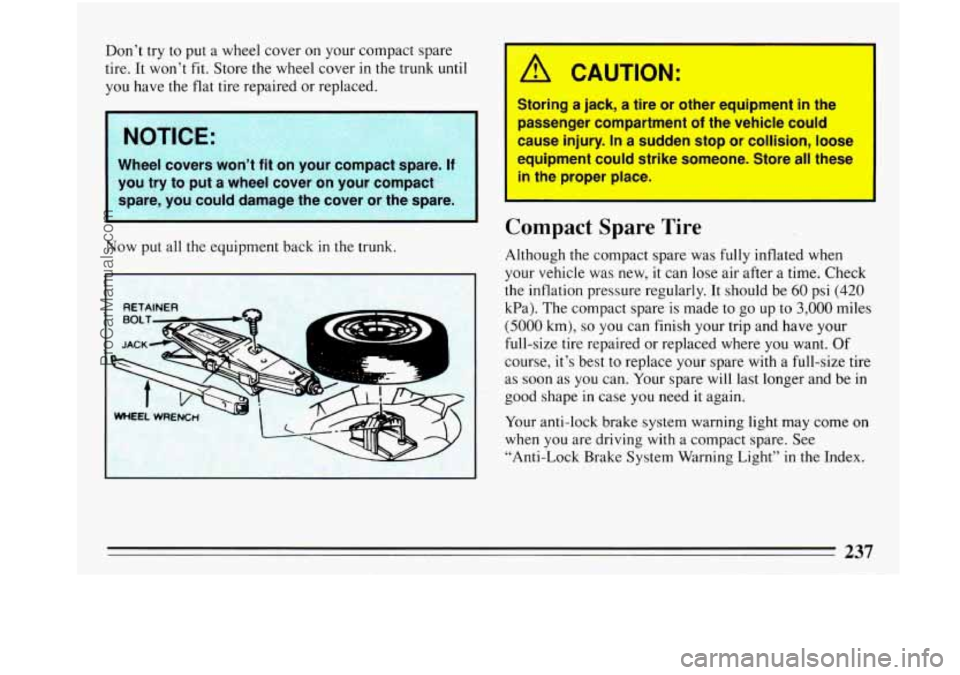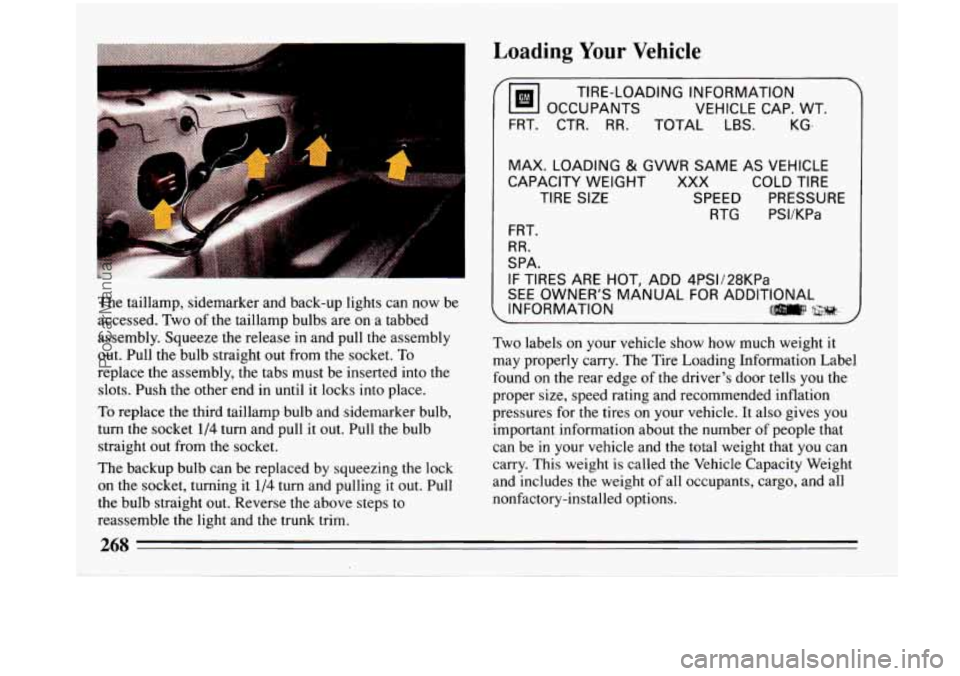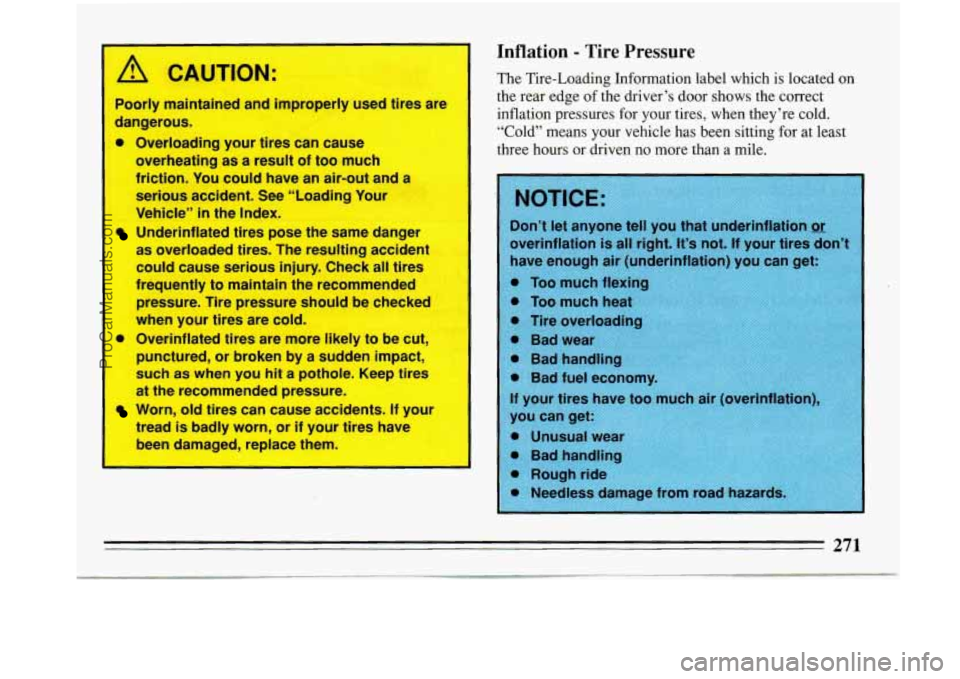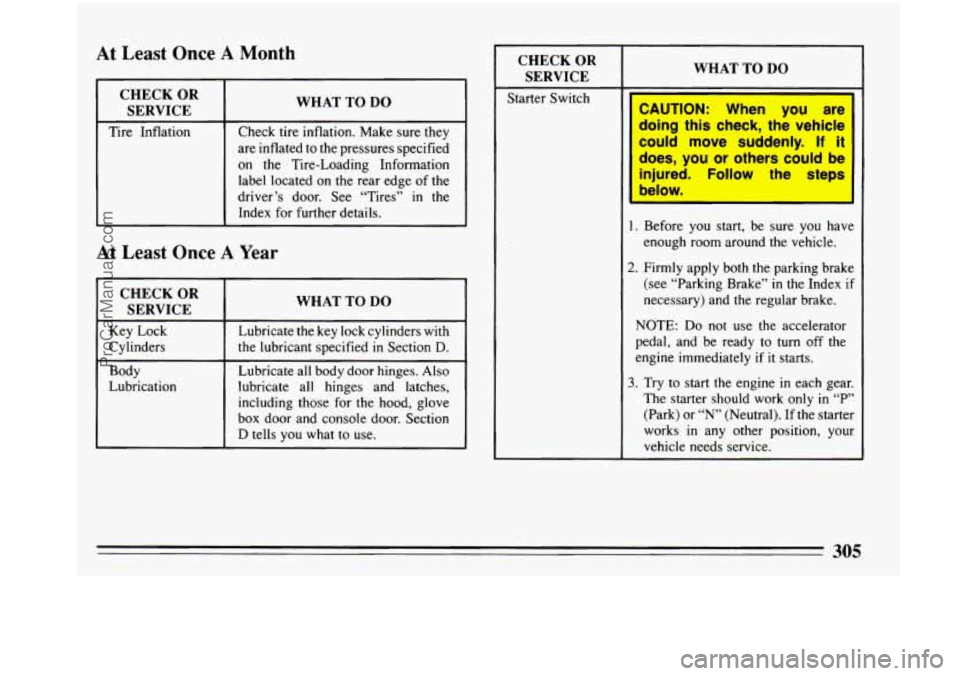Page 239 of 340

Don’t try to put a wheel cover on your compact spare
tire.
It won’t fit. Store the wheel cover in the trunk until
you have the
flat tire repaired or replaced.
I NOTICE:
Now put all the equipment back in the trunk.
WHEEL WRENCH
A CAU I ION:
Storing a jack, a tire or other equilpment in the
passenger compartment of the vehicle could
cause injury. In a sudden stop or collision, loose
equipment cowtd strike someone. Store all these
in the proper
place.
Compact Spare Tire
Although the compact spare was fully inflated when
your vehicle was new, it can lose air after a time. Check
the inflation pressure regularly. It should be
60 psi (420
kPa). The compact spare is made to go up to 3,000 miles
(5000 km), so you can finish your trip and have your
full-size tire repaired
or replaced where you want. Of
course, it’s best to replace your spare with a full-size tire
as soon as you can. Your spare will last longer and be in
good shape
in case you need it again.
Your anti-lock brake system warning light may come on
when
you are driving with a compact spare. See
“Anti-Lock Brake System Warning Light’’ in the Index.
237
ProCarManuals.com
Page 270 of 340

1
Loading Your Vehicle
The taillamp, sidemarker and back-up lights can now be
accessed. Two of the taillamp bulbs are on a tabbed
assembly. Squeeze the release in and pull the assembly
out. Pull the bulb straight out from the socket. To
replace the assembly, the tabs must be inserted into the
slots. Push the other end in until it locks into place.
To replace the third taillamp bulb and sidemarker bulb,
turn the socket
1/4 turn and pull it out. Pull the bulb
straight out from the socket.
The backup bulb can be replaced by squeezing the lock
on the socket, turning it
l/4 turn and pulling it out. Pull
the bulb straight out. Reverse the above steps
to
reassemble the light and the trunk trim.
Tm OCCUPANTS
VEHICLE CAP. WT.
TIRE-LOADING INFORMATION
FRT. CTR.
RR. TOTAL LBS.
.~ ~~ . . ~
KG-
MAX. LOADING
& GVWR SAME AS VEHICLE
CAPACITY WEIGHT XXX COLD TIRE
TIRE SIZE SPEED PRESSURE RTG PSVKPa
FRT.
RR.
SPA.
IF TIRES ARE HOT, ADD 4PSV28KPa
SEE OWNER'S MANUAL FOR ADDITIONAL
INFORMATION
ll]m\:l .$$;;r#, : M
Two labels on your vehicle show how much weight it
may properly carry. The Tire Loading Information Label
found on the rear edge of the driver's door tells you the
proper size, speed rating and recommended inflation
pressures for the tires
on your vehicle. It also gives you
important information about the number
of people that
can be in your vehicle and the total weight that you can
carry. This weight
is called the Vehicle Capacity Weight
and includes the weight of all occupants, cargo, and all
nonfactory-installed options.
268
ProCarManuals.com
Page 273 of 340

1 /rl CAUTION:
I
I
Poorly maintained and improperly used tires are I
dangerous.
0 Overloading your tires can cause
overheating as
a result of too much
friction. You could have an air-out and a
serious accident. See “Loading Your
Vehicle”
in the Index.
Underinflated tires pose the same danger
as overloaded tires. The resulting accident
could cause serious injury. Check all tires
frequently to maintain the recommended
pressure. Tire pressure should checked
when your tires are cold.
0 Overinflated tires are more likely to be cut,
punctured, or broken by
a sudden impact,
such
as when you hit a pothole. Keep tires
at the recommended pressure.
Worn, old tires can cause accidents. If your
tread is badly worn, or if your tires have
been damaged, replace them.
I- -
Inflation - Tire Pressure
The Tire-Loading Information label which is located on
the rear edge of the driver’s door shows the correct
inflation pressures
for your tires, when they’re cold.
“Cold” means your vehicle has been sitting for at least.
three hours or driven
-- 3 more than a mile.
NOTICE:
Don’t let anyone tell you that underinflation
,overinflation
is
ProCarManuals.com
Page 274 of 340
When to Check: Check your tires once a month or
more.
Don’t forget your compact spare tire. It should be at
60
psi (420 Ha).
How to Check: Use a good quality pocket-type gage to
check tire pressure. Simply looking
at the tires will not
tell you the pressure, especially
if you have radial tires --
which may look properly inflated even if they’re
underinflated.
i
If your tires have valve caps, be sure to put them back
on. They help prevent leaks by keeping out dirt and
moisture.
Tire Inspection and Rotation
To make your tires last longer, have them inspected and
rotated at the mileages recommended
in the
Maintenance Schedule. See “Scheduled Maintenance Services” in the Index. Use
this rotation
pattern.
After the tires have been rotated, adjust the front and
rear inflation pressure as shown on the Tire-Loading
Information label. Make certain that all wheel nuts are
properly tightened. See “Wheel Nut Torque”
in the
Index.
ProCarManuals.com
Page 307 of 340

At Least Once A Month
WHAT TO DO
Tire Inflation Check
tire inflation. Make sure they
are inflated to
the pressures specified
on the Tire-Loading Information
label located
on the rear edge of the
driver’s door. See “Tires” in the
Index for further details.
At Least Once A Year
CHECK OR
SERVICE
I WHAT TO DO
Key Lock Lubricate the key lock cylinders with
Cylinders the lubricant specified in Section D.
Body Lubricate all body door hinges. Also
Lubrication lubricate all hinges and latches,
including those’ for the hood, glove
box door and console door. Section
D tells you what to use.
CHECK OR
SERVICE I WHAT TO DO
Starter Switch
I
1. Before you start, be sure you have
enough room around the vehicle.
2. Firmly apply both the parking brake
(see “Parking Brake”
in the Index if
necessary) and the regular brake.
NOTE:
Do not use the accelerator
pedal, and be ready to turn
off the
engine immediately
if it starts.
3. Try to start the engine in each gear.
The starter should work only
in “P”
(Park) or “N” (Neutral). If the starter
works in any other position, your
vehicle needs service.
ProCarManuals.com